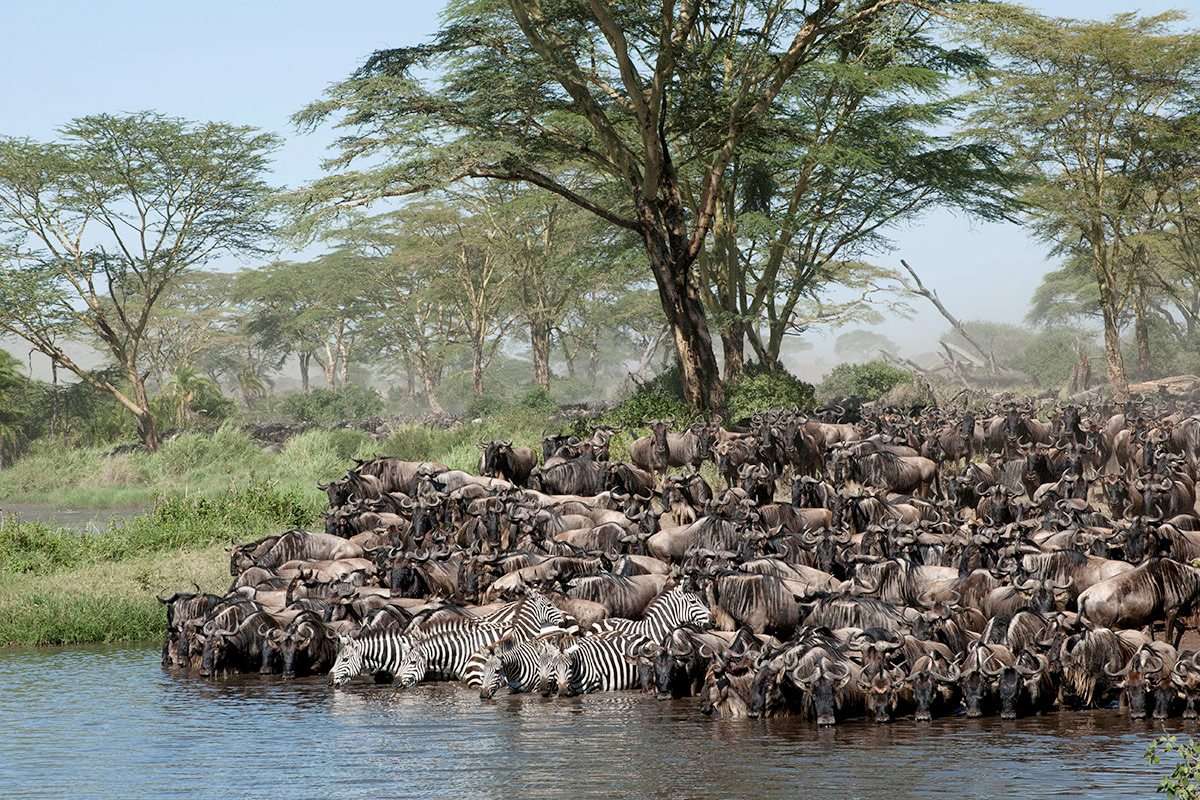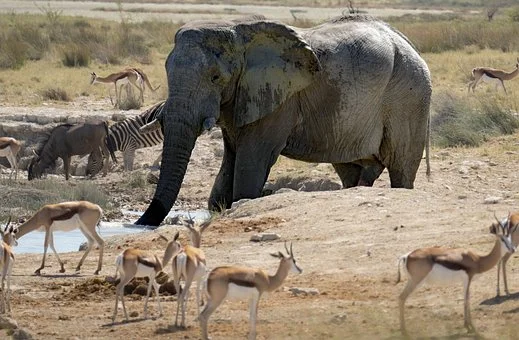the Great Migration Safari: Great Migration 2025 Dates

We are on a Great Migration Safari in the Masai Mara. The first time for the six tourists I’m guiding for the day. And for me? Well, I’ve honestly lost count.
As the sun begins to rise, Chris, our driver, takes us to the edge of the savannah where I excitedly point to a herd of approaching wildebeests.
“The first herd has just arrived from the Serengeti. There will be about 700,000 more by afternoon,” I remark.
You see, the Great Wildebeest Migration is the largest of its kind on the planet. It is graced by over 1.5 million wildebeests, 300,000 zebras, and countless grant’s gazelle, elands, and impalas.
In this article, I tell you all you need to know about this recognized wonder of the world; from where it happens, how it happens, and why it happens.
I also tell you about our migration safari packages and why you should book one with us.
Our 2025 Great Migration Safari Packages
Why Choose Kenya Luxury Safari?
When Kenya Luxury Safari was founded almost two decades ago, our mission was simple- to provide intimate safari experiences that stay with you.
For us, that has meant going far and beyond the expected even for the briefest of trips. It has meant tailoring each safari to the varying, sometimes unspoken, needs of our guests. It has meant bringing together a team of passionate, experienced individuals and only working with the most reliable, reputable suppliers in the business.
Choose us and your migration safari will be more than a collection of sights and sounds. It will become an experience that you treasure forever.
For bookings, call or WhatsApp us at +254-704-532-105 or send us an email at safarioffers@kenyasafariholidays.uk, safarioffers@ajkenyasafaris.com, or james@ajkenyasafaris.com
What is the Great Migration 2025?

Every year, over 1.5 million wildebeests, zebras, gazelles, and elands journey across the Serengeti-Mara ecosystem with two things only in mind- fresh grazing lands and water.
The journey is pleasant and grueling; pleasant because along the way thousands are born and grueling because of the thousands of lives lost to predators, exhaustion, and dehydration.
It is remarkable and heart-wrenching to watch, a reason why it’s dubbed the greatest show on earth.
Here are Some More Fascinating Facts About the Great Migration
- It is the world’s largest overland migration made up of almost 1.5 million wildebeest, 300,000 zebra, 500,000 Thomson’s gazelle, and 18,000 eland. It is also graced by countless predators including the lion, wild dog, cheetah, hippo, hyena, leopard, and fox.
- The Great Migration is recognized as one of the seven wonders of the world.
- The Great Migration can be seen from space! Yup, you heard that right! It is hard to miss it when there are approximately 1,000 animals per km2.
- Uh-huh, we’ve all read it or seen it on TV somewhere- ‘the annual event’. But is it actually an event? Well, no it is NOT! The Great Wildebeest Migration is actually a cyclic, year-long process dictated primarily by the rains.
- 800 to 1000km! That’s the total distance each migrating animal covers!
- The migrating animals follow an age-old route that loops through Tanzania’s Serengeti National Park and Kenya’s Masai Mara.
Why do the Wildebeest and Zebra Migrate?
Guided purely by the need for survival, the migrating animals travel for over 1000km in search of fresh grazing lands and water. On their journey, the herds cross crocodile-infested rivers, face the wrath of adverse weather, and battle vicious blood-thirsty predators.
It is a journey of survival, one that has taken place for centuries and will continue to take place in the future.
When Is the 2025 Great Migration Start Dates?

Although it’s difficult to pinpoint when the Great Migration starts, it seems reasonable to call the wildebeest birthing season the start of the migration.
That said, the migration can then be described as a continuous loop of movement that takes animals from the Ngorongoro Conservation Area in the south of Tanzania’s Serengeti to the Serengeti National Park itself, then up to the Masai Mara National Reserve in Kenya and back again.
When is the Great Migration: a Month by Month Breakdown

Again, we’d like to reiterate that there is no telling where or when the migration starts. The migration, as previously mentioned, is triggered by the rains which have become increasingly difficult to predict due to climate change.
We can, however, give you a general timeline so that you can have an idea of where and when to expect the animals.
Here’s a month-by-month breakdown of the Mara-Serengeti Migration.
January, February, and March
At this time, the migrating herds are in the Serengeti heading south toward the short grass plains of the Ngorongoro Conservation Area. It is around late January or early February when the herds finally settle in the Ngorongoro Conservation Area which makes a fine calving ground thanks to its nutritious grasses.
In February, the calving season officially begins. And believe it or not, almost 8,000 calves are born daily.
Now, the presence of vulnerable young calves means there will be hundreds of blood-hungry predators lurking around, so this is the time to observe big cats in action.
April: Mating Season
April marks the beginning of the Apr-May long rains and being ones to take a hint, the wildebeest herds head north towards Central Serengeti. Along the way, a few friends tag along (read zebras and antelopes), and together these newly acquainted buddies journey hundreds of kilometers to the Simba and Moru Kopjes.
The Kopjes, for some reason, seem to ramp up testosterone and within no time the mating season begins.
May: the Grumeti River Crossing
Calves are a little bit stronger which only means one thing- it’s go time! The wildebeests begin to mass in Serengeti’s western corridor and when huge numbers form, the first river crossing happens- the Grumeti River crossing.
Although not as spectacular as the Mara River crossing, the Grumeti River crossing is no less thrilling to witness.
June and July: Crossing the Mara River
The dry season, which begins in June, finds the wildebeests in Western Serengeti and on the southern banks of the Grumeti River.
From there, the animals slowly graze their way toward northern Serengeti, soon finding themselves on the banks of the Mara River where they must make their most dangerous river crossing yet.
We call it the iconic Mara River Crossing, a brutal event that claims the lives of almost half a million wildebeest and zebra. It’s a bloodbath, one that is as necessary as it is brutal.
August, September, and October
While a significant number of the migrating animals still remain in northern Serengeti, a huge number of them have made it past the Mara River and are now settled in the northern plains of the Masai Mara. The river crossings continue from August to early September and by mid-September, the animals are well settled in the Masai Mara plains.
In October, the wildebeest migrate eastward of the Masai Mara National Park.
November and December
The short rains begin in late October. In early November, the herds leave the Masai Mara for the now rejuvenated Serengeti. By December, these animals are well spread out in east and southern Serengeti.
When is the Best Time to go For a 2025 Migration Safari?
It really all comes down to what you want to see. Here’s a detailed breakdown of the events that happen during the Wildebeest crossing and when and where they happen.
|
Occasion |
Estimated Time |
Place |
|
Calving season |
February |
Southern Serengeti- Ngorongoro Crater |
|
Breeding season |
April to May |
Central and Western Serengeti |
|
Grumeti River Crossings |
May to June |
Central Serengeti |
|
Mara River Crossings |
June to early September |
Northern Serengeti and Masai Mara |
Great Migration Camps: Where Should I Stay to Make the Most of the 2025 Wildebeest Migration?

There are more mobile camps and permanent lodges than one can count in the Mara and Serengeti combined.
Here are 5 of our favorite places to stay for the best views of the great migration.
The Governor’s Camp
Set on the banks of the Mara River, on the direct path of the wildebeest Migration, the Governor’s camp truly is the epitome of Mara excellence. Everything’s top-tier here, from the rooms to the ambiance to the amenities and boy are those views of the park to die for.
Kichwa Tembo Camp
Now, Kichwa Tembo is the stuff of legend- set in the heart of the Mara, along the Saparingo River on the edge of the Olololo escarpment. The rooms? Le Magnifique too and comprising of 20 superior tents, 8 superior view tents, and 12 classic tents.
You’ll also love the camp’s riveting views of the Mara and that it’s set on the seasonal path of the great wildebeest migration.
The Serengeti Safari Camp
Interested in watching the calving season? The Serengeti Safari Camp is the place to be. Located in the heart of southern Serengeti, close to Lake Ndutu, the camp possesses a certain level of pizzazz that is hard to find elsewhere!
It also offers exceptional services and even better walking safaris and game drives. The catch? It is only open for six months (for the calving season).
Singita Faru Faru
Set in the private Grumeti Reserve in western Serengeti, the Singita Faru Faru Lodge is majestic indoors and out.
The views of the Serengeti migration here are unparalleled, with gazelles vying for space alongside wildebeest and zebras as they wade across the Grumeti River.
Mara Serena Safari Lodge
You cannot mention exceptional great wildebeest migration camps and leave out Mara Serena. Set on the banks of the Talek River in the middle of the migration route, this lodge offers uninterrupted views of the Wildebeest Migration. The ambiance is unparalleled too and so are the rooms and amenities.
Serena Kirawira Tented Camp
With all its twenty-five tents offering awe-inducing views of the Serengeti’s Western Corridor, the Serena Kirawira Tented is an unbeaten spot to catch the wildebeest migration. The camp also has lots of activities to enjoy, from game drives to hot-air balloon trips.
It is also located just a few minutes away from the Grumeti, which makes it an ideal spot to catch the river crossings.
Frequently Asked Questions
We answer some of your most frequently asked questions about the Great Migration of Africa.
Can the Mara River Crossings be Predicted?
No, they can’t be predicted. The movements of the wildebeest are primarily dictated by the rains which, due to climate change, have become incredibly difficult to predict. So there’s really no knowing when that first wildebeest will make its leap into the Mara River.
Is the Great Migration worth it?
Judging by the sheer numbers alone, you bet it is. The pure horror and excitement that comes with watching the migration is an experience like no other, one which cannot be replicated in any other two national parks in the world.
Like truly, where else in the world would you find over two million wildebeest and zebra moving in one direction? Where else in the world can you witness the brutality of nature and still feel so alive?
The answer is nowhere else. The migration is utterly unique and absolutely worth the experience.
Which is better Serengeti or Masai Mara?
The Mara and Serengeti share the same ecosystem so there’s really not much of a difference when it comes to their wildlife diversity, climate, and landscape.
The Serengeti, however, is much larger than the Mara and offers more in terms of wildlife numbers. Here’s the catch though- due to its small size, wildlife densities are better in the Mara making it better for game drives.
The Mara is also cheaper to safari in than the Serengeti. Park entry fees are higher in the Serengeti and accommodation tends to cost more due to the lack of diversity, which brings us to our next point- infrastructure.
Infrastructure is also more developed in Mara. We are talking roads, lodges, campgrounds, security, you name it. There is also more variety when it comes to accommodations and flight options in Kenya. As we know, increased supply brings down prices.


















